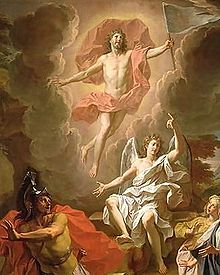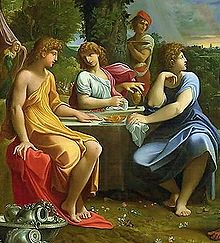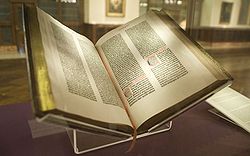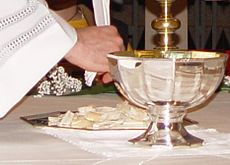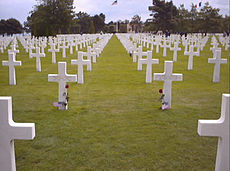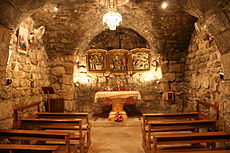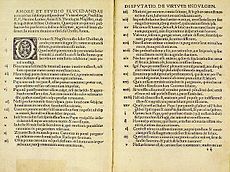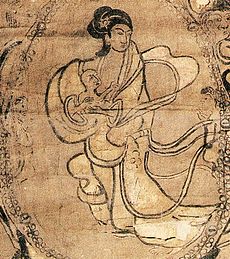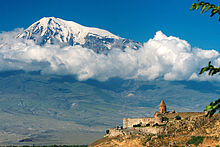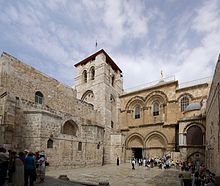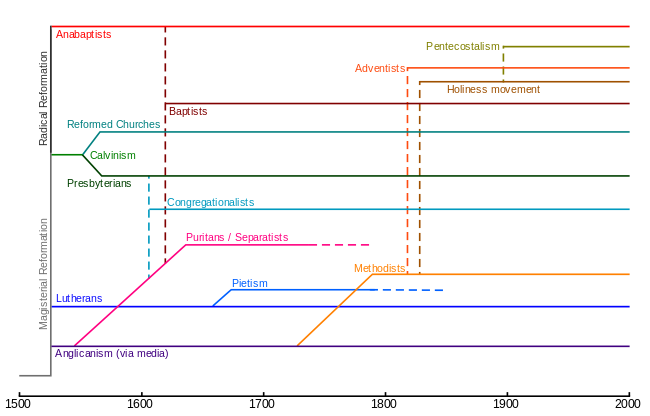
Christianity
Background Information
SOS Children produced this website for schools as well as this video website about Africa. To compare sponsorship charities this is the best sponsorship link.
Christianity (from the Greek: Χριστιανός Christianos and the Latin suffix -itas) is a monotheistic and Abrahamic religion based on the life and teachings of Jesus Christ as presented in canonical gospels and other New Testament writings. Most adherents of the Christian faith, known as Christians, believe that Jesus is the Son of God, fully divine and fully human and the savior of humanity prophesied in the Old Testament. Consequentially, Christians commonly refer to Jesus as Christ or Messiah.
The foundation of Christian theology is expressed in the early ecumenical creeds which contain claims predominantly accepted by followers of the Christian faith. These professions state that Jesus suffered, died, was buried, and was subsequently resurrected from the dead in order to grant eternal life to those who believe in him and trust him for the remission of their sins. They further maintain that Jesus bodily ascended into heaven where he rules and reigns with God the Father. Most denominations teach that Jesus will return to judge all humans, living and dead, and grant eternal life to his followers. He is considered the model of a virtuous life, and his ministry, crucifixion, and resurrection are often referred to as the gospel, meaning " Good News" (from the Greek: εὐαγγέλιον euangélion).
Christianity began as a Jewish sect in the mid-1st century. Originating in the Levant region of the Middle East, it quickly spread to Syria, Mesopotamia, Asia Minor and Egypt. It grew in size and influence over a few centuries, and by the end of the 4th century had become the official state church of the Roman Empire, replacing other forms of religion practiced under Roman rule. During the Middle Ages, most of the remainder of Europe was Christianized, with Christians also being a sometimes large religious minority in the Middle East, North Africa, Ethiopia and parts of India. Following the Age of Discovery, Christianity spread to the Americas, Australasia, sub-Saharan Africa, and the rest of the world through missionary work and colonization. Christianity has played a prominent role in the shaping of Western civilization.
Worldwide, the three largest groups of Christianity are the Roman Catholic Church, the Eastern Orthodox Church, and the various denominations of Protestantism. The Roman Catholic and Eastern Orthodox patriarchates split from one another in the schism of the 11th century, and Protestantism came into existence during the Reformation of the 16th century, splitting from the Roman Catholic Church. As of the early 21st century, Christianity is the world's largest religion, with approximately 2.2 billion adherents.
Beliefs
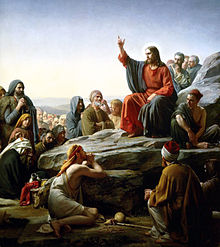
Though there are many important differences of interpretation and opinion of the Bible on which Christianity is based, Christians share a set of beliefs that they hold as essential to their faith.
Creeds
Creeds (from Latin credo meaning "I believe") are concise doctrinal statements or confessions, usually of religious beliefs. They began as baptismal formulae and were later expanded during the Christological controversies of the 4th and 5th centuries to become statements of faith.
Many evangelical Protestants reject creeds as definitive statements of faith, even while agreeing with some or all of the substance of the creeds. The Baptists have been non-creedal "in that they have not sought to establish binding authoritative confessions of faith on one another." Also rejecting creeds are groups with roots in the Restoration Movement, such as the Christian Church (Disciples of Christ), the Evangelical Christian Church in Canada and the Churches of Christ.

The Apostles' Creed remains the most popular statement of the articles of Christian faith that are generally acceptable to most Christian denominations that are creedal. It is widely used by a number of Christian denominations for both liturgical and catechetical purposes, most visibly by liturgical Churches of Western Christian tradition, including the Latin Rite of the Catholic Church, Lutheranism, Anglicanism, and Western Orthodoxy. It is also used by Presbyterians, Methodists, and Congregationalists. This particular creed was developed between the 2nd and 9th centuries. Its central doctrines are those of the Trinity and God the Creator. Each of the doctrines found in this creed can be traced to statements current in the apostolic period. The creed was apparently used as a summary of Christian doctrine for baptismal candidates in the churches of Rome.
Its main points:
- belief in God the Father, Jesus Christ as the Son of God and the Holy Spirit
- the death, descent into hell, resurrection, and ascension of Christ
- the holiness of the Church and the communion of saints
- Christ's second coming, the Day of Judgement and salvation of the faithful.
The Nicene Creed, largely a response to Arianism, was formulated at the Councils of Nicaea and Constantinople in 325 and 381 respectively and ratified as the universal creed of Christendom by the First Council of Ephesus in 431.
The Chalcedonian Creed, developed at the Council of Chalcedon in 451, though rejected by the Oriental Orthodox Churches, taught Christ "to be acknowledged in two natures, inconfusedly, unchangeably, indivisibly, inseparably": one divine and one human, and that both natures are perfect but are nevertheless perfectly united into one person.
The Athanasian Creed, received in the Western Church as having the same status as the Nicene and Chalcedonian, says: "We worship one God in Trinity, and Trinity in Unity; neither confounding the Persons nor dividing the Substance."
Most Christians (Roman Catholics, Eastern Orthodox, Eastern Rite and Protestants alike) accept the use of creeds, and subscribe to at least one of the creeds mentioned above.
Ten Commandments
The Ten Commandments, are a set of biblical principles relating to ethics and worship, which play a fundamental role in Judaism and most forms of Christianity. They include instructions to worship only God and to keep the Sabbath, and prohibitions against idolatry, blasphemy, murder, theft, and adultery. Different groups follow slightly different traditions for interpreting and numbering them. According to the synoptic gospels, Christ generalised the law into two underlying principles; The first is Hear, O Israel: The Lord our God, the Lord is one; and you shall love the Lord your God with all your heart, and with all your soul, and with all your mind, and with all your strength. While the second is You shall love your neighbour as yourself.[ Matthew 22:34-40][ Mark 12:28-33] These are in fact quotes from Deuteronomy 6:4 and Leviticus 19:18. Barnes' Notes on the New Testament comments on these verses saying: "These comprehend the substance of what Moses in the law, and what the prophets have spoken. What they have said has been to endeavour (sic) to win men to the love of God and each other. Love to God and man comprehends the whole [of] religion; and to produce this has been the design of Moses, the prophets, the Saviour, and the apostles."
Jesus Christ
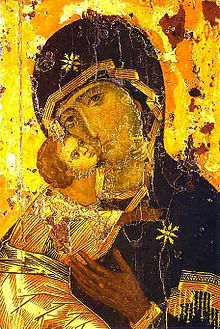
The central tenet of Christianity is the belief in Jesus as the Son of God and the Messiah (Christ). Christians believe that Jesus, as the Messiah, was anointed by God as savior of humanity, and hold that Jesus' coming was the fulfillment of messianic prophecies of the Old Testament. The Christian concept of the Messiah differs significantly from the contemporary Jewish concept. The core Christian belief is that through belief in and acceptance of the death and resurrection of Jesus, sinful humans can be reconciled to God and thereby are offered salvation and the promise of eternal life.
While there have been many theological disputes over the nature of Jesus over the earliest centuries of Christian history, Christians generally believe that Jesus is God incarnate and " true God and true man" (or both fully divine and fully human). Jesus, having become fully human, suffered the pains and temptations of a mortal man, but did not sin. As fully God, he rose to life again. According to the Bible, "God raised him from the dead", he ascended to heaven, is "seated at the right hand of the Father" and will ultimately return[ Acts 1:9–11] to fulfill the rest of Messianic prophecy such as the Resurrection of the dead, the Last Judgment and final establishment of the Kingdom of God.
According to the canonical gospels of Matthew and Luke, Jesus was conceived by the Holy Spirit and born from the Virgin Mary. Little of Jesus' childhood is recorded in the canonical Gospels, however infancy Gospels were popular in antiquity. In comparison, his adulthood, especially the week before his death, is well documented in the Gospels contained within the New Testament. The Biblical accounts of Jesus' ministry include: his baptism, miracles, preaching, teaching, and deeds.
Death and resurrection of Jesus
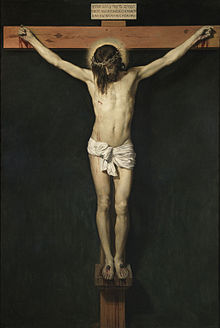
Christians consider the resurrection of Jesus to be the cornerstone of their faith (see 1 Corinthians 15) and the most important event in human history. Among Christian beliefs, the death and resurrection of Jesus are two core events on which much of Christian doctrine and theology is based. According to the New Testament Jesus was crucified, died a physical death, was buried within a tomb, and rose from the dead three days later.[ Jn. 19:30–31] [ Mk. 16:1] [ 16:6] The New Testament mentions several resurrection appearances of Jesus on different occasions to his twelve apostles and disciples, including "more than five hundred brethren at once",[ 1Cor 15:6] before Jesus' Ascension to heaven. Jesus' death and resurrection are commemorated by Christians in all worship services, with special emphasis during Holy Week which includes Good Friday and Easter Sunday.
The death and resurrection of Jesus are usually considered the most important events in Christian theology, partly because they demonstrate that Jesus has power over life and death and therefore has the authority and power to give people eternal life.
Christian churches accept and teach the New Testament account of the resurrection of Jesus with very few exceptions. Some modern scholars use the belief of Jesus' followers in the resurrection as a point of departure for establishing the continuity of the historical Jesus and the proclamation of the early church. Some liberal Christians do not accept a literal bodily resurrection, seeing the story as richly symbolic and spiritually nourishing myth. Arguments over death and resurrection claims occur at many religious debates and interfaith dialogues. Paul the Apostle, an early Christian convert and missionary, wrote, "If Christ was not raised, then all our preaching is useless, and your trust in God is useless."[ 1Cor 15:14]
Salvation
Paul of Tarsus, like Jews and Roman pagans of his time, believed that sacrifice can bring about new kinship ties, purity, and eternal life. For Paul the necessary sacrifice was the death of Jesus: Gentiles who are "Christ's" are, like Israel, descendants of Abraham and "heirs according to the promise".[ Gal. 3:29] The God who raised Jesus from the dead would also give new life to the "mortal bodies" of Gentile Christians, who had become with Israel the "children of God" and were therefore no longer "in the flesh".[ Rom. 8:9,11,16]
Modern Christian churches tend to be much more concerned with how humanity can be saved from a universal condition of sin and death than the question of how both Jews and Gentiles can be in God's family. According to both Catholic and Protestant doctrine, salvation comes by Jesus' substitutionary death and resurrection. The Catholic Church teaches that salvation does not occur without faithfulness on the part of Christians; converts must live in accordance with principles of love and ordinarily must be baptized. Martin Luther taught that baptism was necessary for salvation, but modern Lutherans and other Protestants tend to teach that salvation is a gift that comes to an individual by God's grace, sometimes defined as "unmerited favour", even apart from baptism.
Christians differ in their views on the extent to which individuals' salvation is pre-ordained by God. Reformed theology places distinctive emphasis on grace by teaching that individuals are completely incapable of self-redemption, but that sanctifying grace is irresistible. In contrast Catholics, Orthodox Christians and Arminian Protestants believe that the exercise of free will is necessary to have faith in Jesus.
Trinity
Trinity refers to the teaching that the one God comprises three distinct, eternally co-existing persons; the Father, the Son (incarnate in Jesus Christ), and the Holy Spirit. Together, these three persons are sometimes called the Godhead, although there is no single term in use in Scripture to denote the unified Godhead. In the words of the Athanasian Creed, an early statement of Christian belief, "the Father is God, the Son is God, and the Holy Spirit is God, and yet there are not three Gods but one God". They are distinct from another: the Father has no source, the Son is begotten of the Father, and the Spirit proceeds from the Father. Though distinct, the three persons cannot be divided from one another in being or in operation.
The Trinity is an essential doctrine of mainstream Christianity. "Father, Son and Holy Spirit" represents both the immanence and transcendence of God. God is believed to be infinite and God's presence may be perceived through the actions of Jesus Christ and the Holy Spirit.
According to this doctrine, God is not divided in the sense that each person has a third of the whole; rather, each person is considered to be fully God (see Perichoresis). The distinction lies in their relations, the Father being unbegotten; the Son being begotten of the Father; and the Holy Spirit proceeding from the Father and (in Western Christian theology) from the Son. Regardless of this apparent difference, the three 'persons' are each eternal and omnipotent.
The word trias, from which trinity is derived, is first seen in the works of Theophilus of Antioch. He wrote of "the Trinity of God (the Father), His Word (the Son) and His Wisdom (Holy Spirit)". The term may have been in use before this time. Afterwards it appears in Tertullian. In the following century the word was in general use. It is found in many passages of Origen.
Trinitarians
Trinitarianism denotes those Christians who believe in the concept of the Trinity. Almost all Christian denominations and Churches hold Trinitarian beliefs. Although the words "Trinity" and "Triune" do not appear in the Bible, theologians beginning in the 3rd century developed the term and concept to facilitate comprehension of the New Testament teachings of God as Father, God as Jesus the Son, and God as the Holy Spirit. Since that time, Christian theologians have been careful to emphasize that Trinity does not imply three gods, nor that each member of the Trinity is one-third of an infinite God; Trinity is defined as one God in three Persons.
Nontrinitarians
Nontrinitarianism refers to theology that rejects the doctrine of the Trinity. Various nontrinitarian views, such as adoptionism or modalism, existed in early Christianity, leading to the disputes about Christology. Nontrinitarianism later appeared again in the Gnosticism of the Cathars in the 11th through 13th centuries, in the Age of Enlightenment of the 18th century, and in some groups arising during the Second Great Awakening of the 19th century.
Scriptures
Christianity, like other religions, has adherents whose beliefs and biblical interpretations vary. Christianity regards the Biblical canon, the Old Testament and New Testament, as the inspired word of God. The traditional view of inspiration is that God worked through human authors so that, what they produced was what God wished to communicate. The Greek word referring to inspiration in 2 Timothy 3:16 is Theopneustos, which literally means "God-breathed". Some believe that divine inspiration makes our present Bibles " inerrant". Others claim inerrancy for the Bible in its original manuscripts, though none of those are extant. Still others maintain that only a particular translation is inerrant, such as the King James Version. Another view closely related is Biblical infallibility or Limited inerrancy, which affirms that the Bible is free of error as a guide to salvation, but may include errors on matters such as history, geography, or science.
The Books of the Bible, considered to be inspired, among Judaism, and the Catholic, Orthodox and Protestant churches vary, thus each define the canon differently, although there is substantial overlap. These variations are a reflection of the range of traditions and councils that have convened on the subject. Every version of the Bible always includes books of the Tanakh, the canon of the Hebrew Bible. This makes up what Christians regard as the Old Testament. The Catholic and Orthodox canons, in addition to the Tanakh, also include the Deuterocanonical Books, as part of the Old Testament. These Books appear in the Septuagint, but are regarded by Protestants to be apocryphal. However, they are considered to be important historical documents which help to inform the understanding of words, grammar and syntax used in the historical period of their conception. Some versions of the Bible include a separate Apocrypha section between the Old Testament and the New Testament. The New Testament, originally written in Koine Greek, contains 27 books which are agreed upon by all churches.
Modern scholarship has raised many issues with the Bible. While the Authorized King James Version is held to by many because of its striking english prose, in fact it was translated from the Erasmus Greek Bible which in turn "was based on a single 12th Century manuscript that is one of the worst manuscripts we have available to us". Much scholarship in the past several hundred years has gone into comparing different manuscripts in order to reconstruct the original text. Another issue is that several books are considered to be forgeries. The injunction that women "be silent and submissive" in 1 Timothy 12 is thought by many to be a forgery by a follower of Paul, a similar phrase in 1 Corinthians 14, which is thought to be by Paul, appears in different places in different manuscripts and is thought to originally be a margin note by a copyist. Other verses in 1 Corinthians contradict this verse such as 1 Corinthians 11:2-16 where women are instructed to wear a covering over their hair "when they pray or prophesies". Clearly when they are not silent! A final issue with the Bible is the selection of which books were included in the New Testament. Other texts have been recovered, such as the Gnostic Gospels of Nag Hammadi. While some of these texts are quite different to what modern Christians are used to, it should be understood that they existed simultaneously in early Christianity with those later selected as canon. The Gospel of Thomas contains much that is familiar with existing Gospels, while it has a gnostic twist so that rather than being completely different there is an element of overlap. The Gospel of John, described as the "gnostic Gospel", is believed to have been a response to the Gospel of Thomas which makes it closer to the original events. And while the Gospel of Thomas verse 113 states: "the Father's kingdom is spread out upon the earth, and people don't see it" the same verse can be found in Luke 17:20-21.
Catholic and Orthodox interpretations
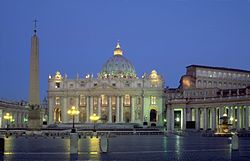
In antiquity, two schools of exegesis developed in Alexandria and Antioch. Alexandrine interpretation, exemplified by Origen, tended to read Scripture allegorically, while Antiochene interpretation adhered to the literal sense, holding that other meanings (called theoria) could only be accepted if based on the literal meaning.
Catholic theology distinguishes two senses of scripture: the literal and the spiritual.
The literal sense of understanding scripture is the meaning conveyed by the words of Scripture. The spiritual sense is further subdivided into:
- the allegorical sense, which includes typology. An example would be the parting of the Red Sea being understood as a "type" (sign) of baptism.[ 1Cor 10:2]
- the moral sense, which understands the scripture to contain some ethical teaching.
- the anagogical sense, which applies to eschatology, eternity and the consummation of the world
Regarding exegesis, following the rules of sound interpretation, Catholic theology holds:
- the injunction that all other senses of sacred scripture are based on the literal
- that the historicity of the Gospels must be absolutely and constantly held
- that scripture must be read within the "living Tradition of the whole Church" and
- that "the task of interpretation has been entrusted to the bishops in communion with the successor of Peter, the Bishop of Rome".
Protestant interpretation
- Clarity of Scripture
- Protestant Christians believe that the Bible is a self-sufficient revelation, the final authority on all Christian doctrine, and revealed all truth necessary for salvation. This concept is known as sola scriptura. Protestants characteristically believe that ordinary believers may reach an adequate understanding of Scripture because Scripture itself is clear (or "perspicuous"), because of the help of the Holy Spirit, or both. Martin Luther believed that without God's help Scripture would be "enveloped in darkness". He advocated "one definite and simple understanding of Scripture". John Calvin wrote, "all who ... follow the Holy Spirit as their guide, find in the Scripture a clear light." The Second Helvetic Confession, composed by the pastor of the Reformed church in Zurich (successor to Protestant reformer Zwingli) was adopted as a declaration of doctrine by most European Reformed churches.
- Original intended meaning of Scripture
- Protestants stress the meaning conveyed by the words of Scripture, the historical-grammatical method. The historical-grammatical method or grammatico-historical method is an effort in Biblical hermeneutics to find the intended original meaning in the text. This original intended meaning of the text is drawn out through examination of the passage in light of the grammatical and syntactical aspects, the historical background, the literary genre as well as theological (canonical) considerations. The historical-grammatical method distinguishes between the one original meaning and the significance of the text. The significance of the text includes the ensuing use of the text or application. The original passage is seen as having only a single meaning or sense. As Milton S. Terry said: "A fundamental principle in grammatico-historical exposition is that the words and sentences can have but one significance in one and the same connection. The moment we neglect this principle we drift out upon a sea of uncertainty and conjecture." Technically speaking, the grammatical-historical method of interpretation is distinct from the determination of the passage's significance in light of that interpretation. Taken together, both define the term (Biblical) hermeneutics.
Some Protestant interpreters make use of typology.
Eschaton
The end of things, whether the end of an individual life, the end of the age, or the end of the world, broadly speaking is Christian eschatology; the study of the destiny of humans as it is revealed in the Bible. The major issues in Christian eschatology are the Tribulation, death and the afterlife, the Rapture, the Second Coming of Jesus, Resurrection of the Dead, Heaven and Hell, Millennialism, the Last Judgment, the end of the world, and the New Heavens and New Earth.
Christians believe that the second coming of Christ will occur at the end of time after a period of severe persecution (the Great Tribulation). All who have died will be resurrected bodily from the dead for the Last Judgment. Jesus will fully establish the Kingdom of God in fulfillment of scriptural prophecies.
Death and afterlife
Most Christians believe that human beings experience divine judgment and are rewarded either with eternal life or eternal damnation. This includes the general judgement at the resurrection of the dead as well as the belief (held by Roman Catholics, Orthodox and most Protestants) in a judgment particular to the individual soul upon physical death.
In Roman Catholicism, those who die in a state of grace, i.e., without any mortal sin separating them from God, but are still imperfectly purified from the effects of sin, undergo purification through the intermediate state of purgatory to achieve the holiness necessary for entrance into God's presence. Those who have attained this goal are called saints (Latin sanctus, "holy").
Some Christian groups, such as Seventh-day Adventists, hold to mortalism, the belief that the human soul is not naturally immortal, and is unconscious during the intermediate state between bodily death and resurrection. These Christians also hold to Annihilationism, the belief that subsequent to the final judgement, the wicked will cease to exist rather than suffer everlasting torment. Jehovah's Witnesses hold to a similar view.
Worship
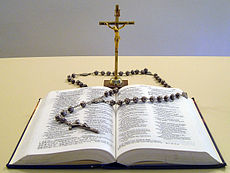
Justin Martyr described 2nd-century Christian liturgy in his First Apology (c. 150) to Emperor Antoninus Pius, and his description remains relevant to the basic structure of Christian liturgical worship:
And on the day called Sunday, all who live in cities or in the country gather together to one place, and the memoirs of the apostles or the writings of the prophets are read, as long as time permits; then, when the reader has ceased, the president verbally instructs, and exhorts to the imitation of these good things. Then we all rise together and pray, and, as we before said, when our prayer is ended, bread and wine and water are brought, and the president in like manner offers prayers and thanksgivings, according to his ability, and the people assent, saying Amen; and there is a distribution to each, and a participation of that over which thanks have been given, and to those who are absent a portion is sent by the deacons. And they who are well to do, and willing, give what each thinks fit; and what is collected is deposited with the president, who succours the orphans and widows and those who, through sickness or any other cause, are in want, and those who are in bonds and the strangers sojourning among us, and in a word takes care of all who are in need.—Justin Martyr
Thus, as Justin described, Christians assemble for communal worship on Sunday, the day of the resurrection, though other liturgical practices often occur outside this setting. Scripture readings are drawn from the Old and New Testaments, but especially the gospel accounts. Often these are arranged on an annual cycle, using a book called a lectionary. Instruction is given based on these readings, called a sermon, or homily. There are a variety of congregational prayers, including thanksgiving, confession, and intercession, which occur throughout the service and take a variety of forms including recited, responsive, silent, or sung. The Lord's Prayer, or Our Father, is regularly prayed. The Eucharist is the part of liturgical worship that consists of a consecrated meal, usually bread and wine.
Some Christian denominations practice closed communion. They offer communion to those who are already united in that denomination or sometimes individual church. Catholics restrict participation to their members who are not in a state of mortal sin. Most other churches practice open communion since they view communion as a means to unity, rather than an end, and invite all believing Christians to participate.
Some groups depart from this traditional liturgical structure. A division is often made between " High" church services, characterized by greater solemnity and ritual, and " Low" services, but even within these two categories there is great diversity in forms of worship. Seventh-day Adventists meet on Saturday, while others do not meet on a weekly basis. Charismatic or Pentecostal congregations may spontaneously feel led by the Holy Spirit to action rather than follow a formal order of service, including spontaneous prayer. Quakers sit quietly until moved by the Holy Spirit to speak. Some Evangelical services resemble concerts with rock and pop music, dancing, and use of multimedia. For groups which do not recognize a priesthood distinct from ordinary believers the services are generally led by a minister, preacher, or pastor. Still others may lack any formal leaders, either in principle or by local necessity. Some churches use only a cappella music, either on principle (for example, many Churches of Christ object to the use of instruments in worship) or by tradition (as in Orthodoxy).
Worship can be varied for special events like baptisms or weddings in the service or significant feast days. In the early church, Christians and those yet to complete initiation would separate for the Eucharistic part of the worship. In many churches today, adults and children will separate for all or some of the service to receive age-appropriate teaching. Such children's worship is often called Sunday school or Sabbath school (Sunday schools are often held before rather than during services).
Sacraments
In Christian belief and practice, a sacrament is a rite, instituted by Christ, that mediates grace, constituting a sacred mystery. The term is derived from the Latin word sacramentum, which was used to translate the Greek word for mystery. Views concerning both what rites are sacramental, and what it means for an act to be a sacrament vary among Christian denominations and traditions.
The most conventional functional definition of a sacrament is that it is an outward sign, instituted by Christ, that conveys an inward, spiritual grace through Christ. The two most widely accepted sacraments are Baptism and the Eucharist (or Holy Communion), however, the majority of Christians also recognize five additional sacraments: Confirmation ( Chrismation in the Orthodox tradition), Holy Orders, Confession, Anointing of the Sick, and Matrimony. Taken together, these are the Seven Sacraments as recognised by churches in the High church tradition—notably Roman Catholic, Eastern Orthodox, Oriental Orthodox, Independent Catholic, Old Catholic most Anglicans, and some Lutherans. Most other denominations and traditions typically affirm only Baptism and Eucharist as sacraments, while some Protestant groups, such as the Quakers, reject sacramental theology. Most Protestant Christian denominations who believe these rites do not communicate grace prefer to call them ordinances.
Justin Martyr described the Eucharist:
And this food is called among us Eukaristia [the Eucharist], of which no one is allowed to partake but the man who believes that the things which we teach are true, and who has been washed with the washing that is for the remission of sins, and unto regeneration, and who is so living as Christ has enjoined. For not as common bread and common drink do we receive these; but in like manner as Jesus Christ our Savior, having been made flesh by the Word of God, had both flesh and blood for our salvation, so likewise have we been taught that the food which is blessed by the prayer of His word, and from which our blood and flesh by transmutation are nourished, is the flesh and blood of that Jesus who was made flesh.—Justin Martyr
Liturgical calendar
Roman Catholics, Anglicans, Eastern Christians, and traditional Protestant communities frame worship around a liturgical calendar. This includes holy days, such as solemnities which commemorate an event in the life of Jesus or the saints, periods of fasting such as Lent, and other pious events such as memoria or lesser festivals commemorating saints. Christian groups that do not follow a liturgical tradition often retain certain celebrations, such as Christmas, Easter and Pentecost. A few churches make no use of a liturgical calendar.
Symbols
The cross, which is today one of the most widely recognised symbols in the world, was used as a Christian symbol from the earliest times. Tertullian, in his book De Corona, tells how it was already a tradition for Christians to trace repeatedly on their foreheads the sign of the cross. Although the cross was known to the early Christians, the crucifix did not appear in use until the 5th century.
Among the symbols employed by the primitive Christians, that of the fish seems to have ranked first in importance. From monumental sources such as tombs it is known that the symbolic fish was familiar to Christians from the earliest times. The fish was depicted as a Christian symbol in the first decades of the 2nd century. Its popularity among Christians was due principally, it would seem, to the famous acrostic consisting of the initial letters of five Greek words forming the word for fish (Ichthys), which words briefly but clearly described the character of Christ and the claim to worship of believers: Iesous Christos Theou Yios Soter, meaning, Jesus Christ, Son of God, Savioufr.
Christians from the very beginning adorned their tombs with paintings of Christ, of the saints, of scenes from the Bible and allegorical groups. The catacombs are the cradle of all Christian art. The first Christians had no prejudice against images, pictures, or statues. The idea that they must have feared the danger of idolatry among their new converts is disproved in the simplest way by the pictures, even statues, that remain from the 1st centuries. Other major Christian symbols include the chi-rho monogram, the dove (symbolic of the Holy Spirit), the sacrificial lamb (symbolic of Christ's sacrifice), the vine (symbolising the necessary connectedness of the Christian with Christ) and many others. These all derive from writings found in the New Testament.
Baptism
Baptism is the ritual act, with the use of water, by which a person is admitted to membership of the Church. Beliefs on baptism vary among denominations. Differences occur firstly, on whether the act has any spiritual significance, some churches hold to the doctrine of Baptismal Regeneration, which affirms that baptism creates or strengthens a person's faith, and is intimately linked to salvation, this view is held by Catholic and Eastern Orthodox churches as well as Lutherans and Anglicans, while others simply acknowledge it as a purely symbolic act, an external public declaration of the inward change which has taken place in the person. Secondly, there are differences of opinion on the methodology of the act. These methods being: Baptism by Immersion; if immersion is total, Baptism by Submersion; and Baptism by Affusion (pouring) and Baptism by Aspersion (sprinkling). Those who hold the first view may also adhere to the tradition of Infant Baptism.
Prayer
Jesus' teaching on prayer in the Sermon on the Mount displays a distinct lack of interest in the external aspects of prayer. A concern with the techniques of prayer is condemned as 'pagan', and instead a simple trust in God's fatherly goodness is encouraged.[ Mat. 6:5–15] Elsewhere in the New Testament this same freedom of access to God is also emphasized.[ Phil. 4:6][ Jam. 5:13–19] This confident position should be understood in light of Christian belief in the unique relationship between the believer and Christ through the indwelling of the Holy Spirit.
In subsequent Christian traditions, certain physical gestures are emphasized, including medieval gestures such as genuflection or making the sign of the cross. Kneeling, bowing and prostrations (see also poklon) are often practiced in more traditional branches of Christianity. Frequently in Western Christianity the hands are placed palms together and forward as in the feudal commendation ceremony. At other times the older orans posture may be used, with palms up and elbows in.
Intercessory prayer is prayer offered for the benefit of other people. There are many intercessory prayers recorded in the Bible, including prayers of the Apostle Peter on behalf of sick persons[ Acts 9:40] and by prophets of the Old Testament in favour of other people.[ 1Ki 17:19–22] In the New Testament book of James no distinction is made between the intercessory prayer offered by ordinary believers and the prominent Old Testament prophet Elijah.[ Jam 5:16–18] The effectiveness of prayer in Christianity derives from the power of God rather than the status of the one praying.
The ancient church, in both Eastern Christianity and Western Christianity, developed a tradition of asking for the intercession of (deceased) saints, and this remains the practice of most Eastern Orthodox, Oriental Orthodox, Roman Catholic, and some Anglican churches. Churches of the Protestant Reformation however rejected prayer to the saints, largely on the basis of the sole mediatorship of Christ. The reformer Huldrych Zwingli admitted that he had offered prayers to the saints until his reading of the Bible convinced him that this was idolatrous.
According to the Catechism of the Catholic Church: "Prayer is the raising of one's mind and heart to God or the requesting of good things from God." The Book of Common Prayer in the Anglican tradition is a guide which provides a set order for church services, containing set prayers, scripture readings, and hymns or sung Psalms.
History
Early Church and Christological Councils
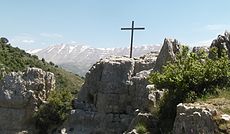
Christianity began as a Jewish sect in the Levant of the middle east in the mid-1st century. Its earliest development took place under the leadership of the Twelve Apostles, particularly Saint Peter and Paul the Apostle, followed by the early bishops, whom Christians consider the successors of the Apostles.
According to the scriptures, Christians were from the beginning subject to persecution by some Jewish religious authorities, who disagreed with the apostles' teachings (See Split of early Christianity and Judaism). This involved punishments, including death, for Christians such as Stephen[ Acts 7:59] and James, son of Zebedee.[ Acts 12:2] Larger-scale persecutions followed at the hands of the authorities of the Roman Empire, first in the year 64, when Emperor Nero blamed them for the Great Fire of Rome. According to Church tradition, it was under Nero's persecution that early Church leaders Peter and Paul of Tarsus were each martyred in Rome. Further widespread persecutions of the Church occurred under nine subsequent Roman emperors, most intensely under Decius and Diocletian. From the year 150, Christian teachers began to produce theological and apologetic works aimed at defending the faith. These authors are known as the Church Fathers, and study of them is called Patristics. Notable early Fathers include Ignatius of Antioch, Polycarp, Justin Martyr, Irenaeus, Tertullian, Clement of Alexandria, and Origen. However, Armenia is considered the first nation to accept Christianity in 301 AD.
State persecution ceased in the 4th century, when Constantine I issued an edict of toleration in 313. On 27 February 380, Emperor Theodosius I enacted a law establishing Nicene Christianity as the state church of the Roman Empire. From at least the 4th century, Christianity has played a prominent role in the shaping of Western civilization.
Constantine was also instrumental in the convocation of the First Council of Nicaea in 325, which sought to address the Arian heresy and formulated the Nicene Creed, which is still used by the Roman Catholic Church, Eastern Orthodoxy, Anglican Communion, and many Protestant churches. Nicaea was the first of a series of Ecumenical (worldwide) Councils which formally defined critical elements of the theology of the Church, notably concerning Christology. The Assyrian Church of the East did not accept the third and following Ecumenical Councils, and are still separate today. In 395, the most Christianized regions of the world were Crete, Cyprus, Anatolia, Armenia, the Nile delta, and Numidia (present-day Tunisia and Algeria).
The presence of Christianity in Africa began in the middle of the 1st century in Egypt, and by the end of the 2nd century in the region around Carthage. Mark the Evangelist started the Orthodox Church of Alexandria in about 43 AD. Important Africans who influenced the early development of Christianity includes Tertullian, Clement of Alexandria, Origen of Alexandria, Cyprian, Athanasius and Augustine of Hippo. The later rise of Islam in North Africa reduced the size and numbers of Christian congregations, leaving only the Coptic Church in Egypt, the Ethiopian Orthodox Tewahedo Church in the Horn of Africa, and the Nubian Church in the Sudan (Nobatia, Makuria, and Alodia).
Early Middle Ages
With the decline and fall of the Roman Empire in the west, the papacy became a political player, first visible in Pope Leo's diplomatic dealings with Huns and Vandals. The church also entered into a long period of missionary activity and expansion among the various tribes. Whilst arianists instituted the death penalty for practicing pagans (see Massacre of Verden as example), Catholicism also spread among the Germanic peoples, the Celtic and Slavic peoples, the Hungarians, and the Baltic peoples. Christianity has been an important part of the shaping of Western civilization, at least since the 4th century.
Around 500, St. Benedict set out his Monastic Rule, establishing a system of regulations for the foundation and running of monasteries. Monasticism became a powerful force throughout Europe, and gave rise to many early centers of learning, most famously in Ireland, Scotland and Gaul, contributing to the Carolingian Renaissance of the 9th century.
In the 7th century Muslims conquered Syria (including Jerusalem), North Africa and Spain. Part of the Muslims' success was due to the exhaustion of the Byzantine empire in its decades long conflict with Persia. Beginning in the 8th century, with the rise of Carolingian leaders, the papacy began to find greater political support in the Frankish Kingdom.
The Middle Ages brought about major changes within the church. Pope Gregory the Great dramatically reformed ecclesiastical structure and administration. In the early 8th century, iconoclasm became a divisive issue, when it was sponsored by the Byzantine emperors. The Second Ecumenical Council of Nicaea (787) finally pronounced in favour of icons. In the early 10th century, Western Christian monasticism was further rejuvenated through the leadership of the great Benedictine monastery of Cluny.
Hebraism, like Hellenism, has been an all-important factor in the development of Western Civilization; Judaism, as the precursor of Christianity, has indirectly had had much to do with shaping the ideals and morality of western nations since the christian era.
High and Late Middle Ages
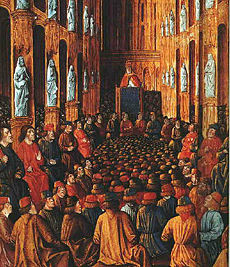
In the west, from the 11th century onward, older cathedral schools developed into universities (see University of Oxford, University of Paris, and University of Bologna.) The traditional medieval universities — evolved from Catholic and Protestant church schools — then established specialized academic structures for properly educating greater numbers of students as professionals. Prof. Walter Rüegg, editor of A History of the University in Europe, reports that universities then only trained students to become clerics, lawyers, civil servants, and physicians. Originally teaching only theology, these steadily added subjects including medicine, philosophy and law, becoming the direct ancestors of modern institutions of learning. The university is generally regarded as an institution that has its origin in the Medieval Christian setting. Prior to the establishment of universities, European higher education took place for hundreds of years in Christian cathedral schools or monastic schools (Scholae monasticae), in which monks and nuns taught classes; evidence of these immediate forerunners of the later university at many places dates back to the 6th century AD.
Accompanying the rise of the "new towns" throughout Europe, mendicant orders were founded, bringing the consecrated religious life out of the monastery and into the new urban setting. The two principal mendicant movements were the Franciscans and the Dominicans founded by St. Francis and St. Dominic respectively. Both orders made significant contributions to the development of the great universities of Europe. Another new order were the Cistercians, whose large isolated monasteries spearheaded the settlement of former wilderness areas. In this period church building and ecclesiastical architecture reached new heights, culminating in the orders of Romanesque and Gothic architecture and the building of the great European cathedrals.
From 1095 under the pontificate of Urban II, the Crusades were launched. These were a series of military campaigns in the Holy Land and elsewhere, initiated in response to pleas from the Byzantine Emperor Alexios I for aid against Turkish expansion. The Crusades ultimately failed to stifle Islamic aggression and even contributed to Christian enmity with the sacking of Constantinople during the Fourth Crusade.
Over a period stretching from the 7th to the 13th century, the Christian Church underwent gradual alienation, resulting in a schism dividing it into a so-called Latin or Western Christian branch, the Roman Catholic Church, and an Eastern, largely Greek, branch, the Orthodox Church. These two churches disagree on a number of administrative, liturgical, and doctrinal issues, most notably papal primacy of jurisdiction. The Second Council of Lyon (1274) and the Council of Florence (1439) attempted to reunite the churches, but in both cases the Eastern Orthodox refused to implement the decisions and the two principal churches remain in schism to the present day. However, the Roman Catholic Church has achieved union with various smaller eastern churches.
Beginning around 1184, following the crusade against the Cathar heresy, various institutions, broadly referred to as the Inquisition, were established with the aim of suppressing heresy and securing religious and doctrinal unity within Christianity through conversion and prosecution.
Protestant Reformation and Counter-Reformation
The 15th-century Renaissance brought about a renewed interest in ancient and classical learning. Another major schism, the Reformation, resulted in the splintering of the Western Christendom into several Christian denominations. Martin Luther in 1517 protested against the sale of indulgences and soon moved on to deny several key points of Roman Catholic doctrine. Others like Zwingli and Calvin further criticized Roman Catholic teaching and worship. These challenges developed into the movement called Protestantism, which repudiated the primacy of the pope, the role of tradition, the seven sacraments, and other doctrines and practices. The Reformation in England began in 1534, when King Henry VIII had himself declared head of the Church of England. Beginning in 1536, the monasteries throughout England, Wales and Ireland were dissolved.
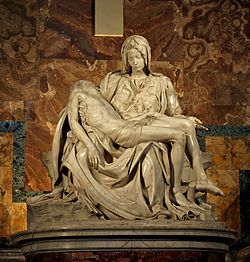
Partly in response to the Protestant Reformation, the Roman Catholic Church engaged in a substantial process of reform and renewal, known as the Counter-Reformation or Catholic Reform. The Council of Trent clarified and reasserted Roman Catholic doctrine. During the following centuries, competition between Roman Catholicism and Protestantism became deeply entangled with political struggles among European states.
Meanwhile, the discovery of America by Christopher Columbus in 1492 brought about a new wave of missionary activity. Partly from missionary zeal, but under the impetus of colonial expansion by the European powers, Christianity spread to the Americas, Oceania, East Asia, and sub-Saharan Africa.
Throughout Europe, the divides caused by the Reformation led to outbreaks of religious violence and the establishment of separate state churches in Europe: Lutheranism in parts of Germany and in Scandinavia and Anglicanism in England in 1534. Ultimately, these differences led to the outbreak of conflicts in which religion played a key factor. The Thirty Years' War, the English Civil War, and the French Wars of Religion are prominent examples. These events intensified the Christian debate on persecution and toleration. Christianity has played a role in shaping of Western civilization.
Post-Enlightenment
In the era known as the Great Divergence, when in the West the Age of Enlightenment and the Scientific revolution brought about great societal changes, Christianity was confronted with various forms of skepticism and with certain modern political ideologies such as versions of socialism and liberalism. Events ranged from mere anti-clericalism to violent outbursts against Christianity such as the Dechristianisation during the French Revolution, the Spanish Civil War, and general hostility of Marxist movements, especially the Russian Revolution.
Especially pressing in Europe was the formation of nation states after the Napoleonic era. In all European countries, different Christian denominations found themselves in competition, to greater or lesser extents, with each other and with the state. Variables are the relative sizes of the denominations and the religious, political, and ideological orientation of the state. Urs Altermatt of the University of Fribourg, looking specifically at Catholicisms in Europe, identifies four models for the European nations. In traditionally Catholic countries such as Belgium, Spain, and to some extent Austria, religious and national communities are more or less identical. Cultural symbiosis and separation are found in Poland, Ireland, and Switzerland, all countries with competing denominations. Competition is found in Germany, the Netherlands, and again Switzerland, all countries with minority Catholic populations who to a greater or lesser extent did identify with the nation. Finally, separation between religion (again, specifically Catholicism) and the state is found to a great degree in France and Italy, countries where the state actively opposed itself to the authority of the Catholic Church. The combined factors of the formation of nation states and ultramontanism, especially in Germany and the Netherlands but also in England (to a much lesser extent), often forced Catholic churches, organizations, and believers to choose between the national demands of the state and the authority of the Church, specifically the papacy. This conflict came to a head in the First Vatican Council, and in Germany would lead directly to the Kulturkampf, where liberals and Protestants under the leadership of Bismarck managed to severely restrict Catholic expression and organization.
Christian commitment in Europe dropped as modernity and secularism came into their own in Europe, particularly in the Czech Republic and Estonia, while religious commitments in America have been generally high in comparison to Europe. The late 20th century has shown the shift of Christian adherence to the Third World and southern hemisphere in general, with the western civilization no longer the chief standard bearer of Christianity.
Some Europeans (including diaspora), Indigenous peoples of the Americas, and natives of other continents have revived their respective peoples' historical folk religions. Approximately 7.1 to 10% of Arabs are Christians most prevalent in Egypt, Syria and Lebanon.
Demographics
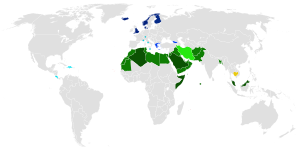
With around 2.2 billion adherents, split into 3 main branches of Catholic, Protestant and Orthodox, Christianity is the world's largest religion. The Christian share of the world's population has stood at around 33% for the last hundred years, which says that one in three persons on earth are Christians. This masks a major shift in the demographics of Christianity; large increases in the developing world (around 23,000 per day) have been accompanied by substantial declines in the developed world, mainly in Europe and North America (around 7,600 per day). It is still the predominant religion in Europe, the Americas and Southern Africa. In Asia, it is the dominant religion in Georgia, Armenia, East Timor and the Philippines. However, it is declining in many areas including the Northern and Western United States, Oceania (Australia and New Zealand), northern Europe (including Great Britain, Scandinavia and other places), France, Germany, the Canadian provinces of Ontario, British Columbia, and Quebec, and parts of Asia (especially the Middle East, South Korea, Taiwan, The Philippines and Macau). The Christian population is not decreasing in Brazil, the Southern United States and the province of Alberta, Canada, but the percentage is decreasing. In countries such as Australia and New Zealand, the Christian population are declining in both numbers and percentage. Despite the declining numbers, Christianity remains the dominant religion in the Western World, where 70% are Christians, in Europe 76.2% of the population considering themselves Christians, and 86.0% of the Americas and 73.36% in Oceania still practice Christianity.
However, there are many charismatic movements that have become well established over large parts of the world, especially Africa, Latin America and Asia. A leading Saudi Arabian Muslim leader Sheikh Ahmad al Qatanni reported on Aljazeera that every day 16,000 African Muslims convert to Christianity. He claimed that Islam was losing 6 million African Muslims a year to becoming Christians, including Muslims in Algeria, France, Iran, India, Morocco, Russia, and Turkey, and Central Asia. It is also reported that Christianity is popular among people of different backgrounds in India (mostly Hindus), and Malaysia, Mongolia, Nigeria, Vietnam, Singapore, Indonesia, China, Japan, and South Korea.
In most countries in the developed world, church attendance among people who continue to identify themselves as Christians has been falling over the last few decades. Some sources view this simply as part of a drift away from traditional membership institutions, while others link it to signs of a decline in belief in the importance of religion in general.
Christianity, in one form or another, is the sole state religion of the following nations: Costa Rica (Roman Catholic), Denmark (Evangelical Lutheran), El Salvador (Roman Catholic), England (Anglican), Finland (Evangelical Lutheran & Orthodox), Georgia (Georgian Orthodox), Greece (Greek Orthodox), Iceland (Evangelical Lutheran), Liechtenstein (Roman Catholic), Malta (Roman Catholic), Monaco (Roman Catholic), and Vatican City (Roman Catholic).
There are numerous other countries, such as Cyprus, which although do not have an established church, still give official recognition to a specific Christian denomination.
Major denominations within Christianity
The three primary divisions of Christianity are Catholicism, Eastern Orthodoxy, and Protestantism. There are other Christian groups that do not fit neatly into one of these primary categories. The Nicene Creed is "accepted as authoritative by the Roman Catholic, Eastern Orthodox, Anglican, and major Protestant churches." There is a diversity of doctrines and practices among groups calling themselves Christian. These groups are sometimes classified under denominations, though for theological reasons many groups reject this classification system. A broader distinction that is sometimes drawn is between Eastern Christianity and Western Christianity, which has its origins in the East–West Schism (Great Schism) of the 11th century.
As well as these modern divisions, there were many diverse Christian communities with wildly different Christologies, eschatologies, soteriologies, and cosmologies that existed alongside the "Early Church" which is itself a projected concept to indicate which communities were "proto-orthodox", in that their views would become dominate. In many ways, the first three centuries of Christianity was significantly more diverse than the modern Church.
| Christian Denominations in English-speaking countries |
||
|---|---|---|
|
Australia
|
||
|
International Associations
Interdenominational Associations
Denominational Associations
Regional Associations Africa
Asia
Caribbean
Europe
Middle East
Latin America
North America
Pacific
|
||
Catholic
The Roman Catholic Church comprises those particular Churches, headed by bishops, in communion with the Pope, the Bishop of Rome, as its highest authority in matters of faith, morality and Church governance. Like the Eastern Orthodox, the Roman Catholic Church through Apostolic succession traces its origins to the Christian community founded by Jesus Christ. Catholics maintain that the " one, holy, catholic and apostolic church" founded by Jesus subsists fully in the Roman Catholic Church, but also acknowledges other Christian churches and communities and works towards reconciliation among all Christians. The Catholic faith is detailed in the Catechism of the Catholic Church.
The 2,834 sees are grouped into 23 particular rites, the largest being the Latin Rite, each with distinct traditions regarding the liturgy and the administering the sacraments. With more than 1.1 billion baptized members, the Catholic Church is the largest church representing over half of all Christians and one sixth of the world's population.
Various smaller communities, such as the Old Catholic and Independent Catholic Churches, include the word Catholic in their title, and share much in common with Roman Catholicism but are no longer in communion with the See of Rome.
Orthodox
Eastern Orthodoxy comprises those churches in communion with the Patriarchal Sees of the East, such as the Ecumenical Patriarch of Constantinople. Like the Roman Catholic Church, the Eastern Orthodox Church also traces its heritage to the foundation of Christianity through Apostolic succession and has an episcopal structure, though the autonomy of the individual, mostly national churches is emphasized. A number of conflicts with Western Christianity over questions of doctrine and authority culminated in the Great Schism. Eastern Orthodoxy is the second largest single denomination in Christianity, with over 200 million adherents.
The Oriental Orthodox Churches (also called Old Oriental Churches) are those eastern churches that recognize the first three ecumenical councils—Nicaea, Constantinople and Ephesus—but reject the dogmatic definitions of the Council of Chalcedon and instead espouse a Miaphysite christology. The Oriental Orthodox communion comprises six groups: Syriac Orthodox, Coptic Orthodox, Ethiopian Orthodox, Eritrean Orthodox, Malankara Orthodox Syrian Church (India) and Armenian Apostolic churches. These six churches, while being in communion with each other are completely independent hierarchically. These churches are generally not in communion with Eastern Orthodox Churches with whom they are in dialogue for erecting a communion.
Protestant
In the 16th century, Martin Luther, Huldrych Zwingli, and John Calvin inaugurated what has come to be called Protestantism. Luther's primary theological heirs are known as Lutherans. Zwingli and Calvin's heirs are far broader denominationally, and are broadly referred to as the Reformed Tradition. Most Protestant traditions branch out from the Reformed tradition in some way. In addition to the Lutheran and Reformed branches of the Reformation, there is Anglicanism after the English Reformation. The Anabaptist tradition was largely ostracized by the other Protestant parties at the time, but has achieved a measure of affirmation in more recent history. Some but not most Baptists prefer not to be called Protestants, claiming a direct ancestral line going back to the apostles in the 1st century.
The oldest Protestant groups separated from the Catholic Church in the 16th century Protestant Reformation, followed in many cases by further divisions. For example, the Methodist Church grew out of Anglican minister John Wesley's evangelical and revival movement in the Anglican Church. Several Pentecostal and non-denominational Churches, which emphasize the cleansing power of the Holy Spirit, in turn grew out of the Methodist Church. Because Methodists, Pentecostals, and other evangelicals stress "accepting Jesus as your personal Lord and Savior", which comes from Wesley's emphasis of the New Birth, they often refer to themselves as being born-again.
Estimates of the total number of Protestants are very uncertain, partly because of the difficulty in determining which denominations should be placed in these categories, but it seems clear that Protestantism is the second largest major group of Christians after Catholicism in number of followers (although the Orthodox Church is larger than any single Protestant denomination). Often that number is put at 800 million. Protestantism, along with the Orthodox Church (appx. 200 million) and the Catholic Church (appx. 1.1 billion) form a total of 2.1 billion Christianity followers.
A special grouping are the Anglican churches descended from the Church of England and organised in the Anglican Communion. Some Anglican churches consider themselves both Protestant and Catholic. Some Anglicans consider their church a branch of the "One Holy Catholic Church" alongside of the Roman Catholic and Eastern Orthodox Churches, a concept rejected by the Roman Catholic Church and some Eastern Orthodox.
Some groups of individuals who hold basic Protestant tenets identify themselves simply as "Christians" or " born-again Christians". They typically distance themselves from the confessionalism and/or creedalism of other Christian communities by calling themselves " non-denominational". Often founded by individual pastors, they have little affiliation with historic denominations.
Restorationists and others
The Second Great Awakening, a period of religious revival that occurred in the United States during the early 1800s, saw the development of a number of unrelated churches. They generally saw themselves as restoring the original church of Jesus Christ rather than reforming one of the existing churches. A common belief held by Restorationists was that the other divisions of Christianity had introduced doctrinal defects into Christianity, which was known as the Great Apostasy.
Some of the churches originating during this period are historically connected to early 19th-century camp meetings in the Midwest and Upstate New York. American Millennialism and Adventism, which arose from Evangelical Protestantism, influenced the Jehovah's Witnesses movement (with 7 million members), and, as a reaction specifically to William Miller, the Seventh-day Adventists. Others, including the Christian Church (Disciples of Christ), Evangelical Christian Church in Canada, Churches of Christ, and the Christian churches and churches of Christ, have their roots in the contemporaneous Stone-Campbell Restoration Movement, which was centered in Kentucky and Tennessee. Other groups originating in this time period include the Christadelphians and Latter Day Saint movement. While the churches originating in the Second Great Awakening have some superficial similarities, their doctrine and practices vary significantly.
Esoteric Christians regard Christianity as a mystery religion, and profess the existence and possession of certain esoteric doctrines or practices, hidden from the public but accessible only to a narrow circle of "enlightened", "initiated", or highly educated people. Some of the esoteric Christian institutions include the Rosicrucian Fellowship, the Anthroposophical Society and the Martinism.
Messianic Judaism (or Messianic Movement) is the name of a Christian movement comprising a number of streams, whose members may identify themselves as Jewish. It blends evangelical theology with elements of religious Jewish practice and terminology. Messianic Judaism affirms the messiahship and divinity of " Yeshua" (the Hebrew name of Jesus), whilst also adhering to aspects of Jewish dietary law and custom.
Christian culture

Western culture, throughout most of its history, has been nearly equivalent to Christian culture, and many of the population of the Western hemisphere could broadly be described as cultural Christians. Though Western culture contained several polytheistic religions during its early years under the Greek and Roman empires, as the centralized Roman power waned, the dominance of the Catholic Church was the only consistent force in Europe. Until the Age of Enlightenment, Christian culture was the predominant force in western civilization, guiding the course of philosophy, art, and science. Christian disciplines of the respective arts have subsequently developed into Christian philosophy, Christian art, etc.
Postchristianity is the term for the decline of Christianity, particularly in Europe, Canada, Australia and to a minor degree the Southern Cone, in the 20th and 21st centuries, considered in terms of postmodernism. It refers to the loss of Christianity's monopoly on values and world view in historically Christian societies.
Cultural Christians are secular people with a Christian heritage who may not believe in the religious claims of Christianity, but who retain an affinity for the popular culture, art, music, and so on related to it. Another frequent application of the term is to distinguish political groups in areas of mixed religious backgrounds.
Ecumenism
Most Christian groups and individual denominations have long expressed ideals of being reconciled with each other, and in the 20th century Christian ecumenism advanced in two ways. One way was greater cooperation between groups, such as the Edinburgh Missionary Conference of Protestants in 1910, the Justice, Peace and Creation Commission of the World Council of Churches founded in 1948 by Protestant and Orthodox churches, and similar national councils like the National Council of Churches in Australia which includes Roman Catholics.
The other way was institutional union with new United and uniting churches. Congregationalist, Methodist, and Presbyterian churches united in 1925 to form the United Church of Canada, and in 1977 to form the Uniting Church in Australia. The Church of South India was formed in 1947 by the union of Anglican, Methodist, Congregationalist, Presbyterian, and Reformed churches.
Steps towards reconciliation on a global level were taken in 1965 by the Roman Catholic and Orthodox churches mutually revoking the excommunications that marked their Great Schism in 1054; the Anglican Roman Catholic International Commission (ARCIC) working towards full communion between those churches since 1970; and the Lutheran and Roman Catholic churches signing the Joint Declaration on the Doctrine of Justification in 1999 to address conflicts at the root of the Protestant Reformation. In 2006, the World Methodist Council, representing all Methodist denominations, adopted the declaration.
Another example of ecumenism is the invention of and growing usage of the Christian Flag, which was designed to represent all of Christendom. The flag has a white field, with a red Latin cross inside a blue canton.
Criticism and apologetics
Criticism of Christianity and Christians goes back to the Apostolic age, with the New Testament recording friction between the followers of Jesus and the Pharisees and scribes (e.g. Mark 7:1-23 and Matthew 15:1-20). In the 2nd century Christianity was criticized by the Jews on various grounds, e.g. that the prophecies of the Hebrew Bible could not have been fulfilled by Jesus, given that he did not have a successful life. By the 3rd century criticism of Christianity had mounted, partly as a defense against it, and the 15 volume Adversus Christianos by Porphyry was written as a comprehensive attack on Christianity, in part building on the pre-Christian concepts of Plotinus.
By the 12th century, the Mishneh Torah (i.e., Rabbi Moses Maimonides) was criticizing Christianity on the grounds of idol worship, in that Christians attributed divinity to Jesus who had a physical body. In the 19th century, Nietzsche began to write a series of attacks on the "unnatural" teachings of Christianity (e.g. avoidance of temptations), and continued anti-Christian attacks to the end of his life. In the 20th century, the philosopher Bertrand Russell expressed his criticism of Christianity in Why I Am Not a Christian, formulating his rejection of Christianity in the setting of logical arguments. Criticism of Christianity continues to date, e.g. Jewish and Muslim theologians criticize the doctrine of the Trinity held by most Christians, stating that this doctrine in effect assumes that there are three Gods, running against the basic tenet of monotheism. New Testament scholar Robert M. Price has outlined the possibility that some Bible stories are based partly on myth in "The Christ Myth Theory and its problems".
In response to criticism, the field of Christian apologetics aims to present a rational basis for Christianity, defending the faith against such objections. The word "apologetic" comes from the Greek word "apologeomai", meaning "in defense of". Christian apologetics has taken many forms over the centuries, starting with Paul the Apostle. The philosopher Thomas Aquinas presented five arguments for God's existence in the Summa Theologica, while his Summa contra Gentiles was a major apologetic work. Different branches of apologetics present defenses against scientific, philosophical and evidential criticism, respectively.
